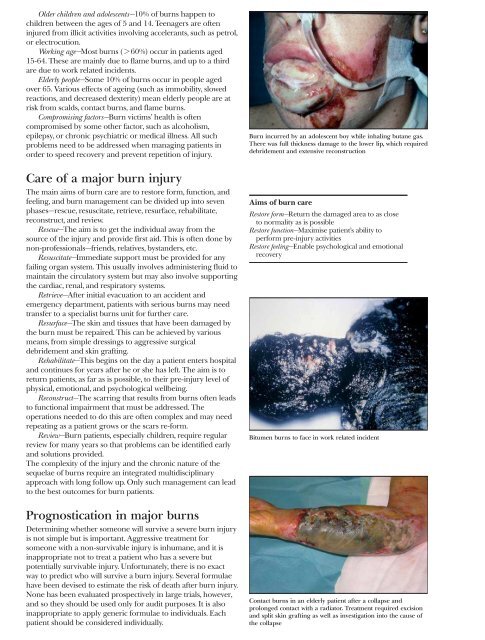ABC of Burns
Create successful ePaper yourself
Turn your PDF publications into a flip-book with our unique Google optimized e-Paper software.
Older children and adolescents—10% <strong>of</strong> burns happen to<br />
children between the ages <strong>of</strong> 5 and 14. Teenagers are <strong>of</strong>ten<br />
injured from illicit activities involving accelerants, such as petrol,<br />
or electrocution.<br />
Working age—Most burns ( > 60%) occur in patients aged<br />
15-64. These are mainly due to flame burns, and up to a third<br />
are due to work related incidents.<br />
Elderly people—Some 10% <strong>of</strong> burns occur in people aged<br />
over 65. Various effects <strong>of</strong> ageing (such as immobility, slowed<br />
reactions, and decreased dexterity) mean elderly people are at<br />
risk from scalds, contact burns, and flame burns.<br />
Compromising factors—Burn victims’ health is <strong>of</strong>ten<br />
compromised by some other factor, such as alcoholism,<br />
epilepsy, or chronic psychiatric or medical illness. All such<br />
problems need to be addressed when managing patients in<br />
order to speed recovery and prevent repetition <strong>of</strong> injury.<br />
Burn incurred by an adolescent boy while inhaling butane gas.<br />
There was full thickness damage to the lower lip, which required<br />
debridement and extensive reconstruction<br />
Care <strong>of</strong> a major burn injury<br />
The main aims <strong>of</strong> burn care are to restore form, function, and<br />
feeling, and burn management can be divided up into seven<br />
phases—rescue, resuscitate, retrieve, resurface, rehabilitate,<br />
reconstruct, and review.<br />
Rescue—The aim is to get the individual away from the<br />
source <strong>of</strong> the injury and provide first aid. This is <strong>of</strong>ten done by<br />
non-pr<strong>of</strong>essionals—friends, relatives, bystanders, etc.<br />
Resuscitate—Immediate support must be provided for any<br />
failing organ system. This usually involves administering fluid to<br />
maintain the circulatory system but may also involve supporting<br />
the cardiac, renal, and respiratory systems.<br />
Retrieve—After initial evacuation to an accident and<br />
emergency department, patients with serious burns may need<br />
transfer to a specialist burns unit for further care.<br />
Resurface—The skin and tissues that have been damaged by<br />
the burn must be repaired. This can be achieved by various<br />
means, from simple dressings to aggressive surgical<br />
debridement and skin grafting.<br />
Rehabilitate—This begins on the day a patient enters hospital<br />
and continues for years after he or she has left. The aim is to<br />
return patients, as far as is possible, to their pre-injury level <strong>of</strong><br />
physical, emotional, and psychological wellbeing.<br />
Reconstruct—The scarring that results from burns <strong>of</strong>ten leads<br />
to functional impairment that must be addressed. The<br />
operations needed to do this are <strong>of</strong>ten complex and may need<br />
repeating as a patient grows or the scars re-form.<br />
Review—Burn patients, especially children, require regular<br />
review for many years so that problems can be identified early<br />
and solutions provided.<br />
The complexity <strong>of</strong> the injury and the chronic nature <strong>of</strong> the<br />
sequelae <strong>of</strong> burns require an integrated multidisciplinary<br />
approach with long follow up. Only such management can lead<br />
to the best outcomes for burn patients.<br />
Prognostication in major burns<br />
Determining whether someone will survive a severe burn injury<br />
is not simple but is important. Aggressive treatment for<br />
someone with a non-survivable injury is inhumane, and it is<br />
inappropriate not to treat a patient who has a severe but<br />
potentially survivable injury. Unfortunately, there is no exact<br />
way to predict who will survive a burn injury. Several formulae<br />
have been devised to estimate the risk <strong>of</strong> death after burn injury.<br />
None has been evaluated prospectively in large trials, however,<br />
and so they should be used only for audit purposes. It is also<br />
inappropriate to apply generic formulae to individuals. Each<br />
patient should be considered individually.<br />
Aims <strong>of</strong> burn care<br />
Restore form—Return the damaged area to as close<br />
to normality as is possible<br />
Restore function—Maximise patient’s ability to<br />
perform pre-injury activities<br />
Restore feeling—Enable psychological and emotional<br />
recovery<br />
Bitumen burns to face in work related incident<br />
Contact burns in an elderly patient after a collapse and<br />
prolonged contact with a radiator. Treatment required excision<br />
and split skin grafting as well as investigation into the cause <strong>of</strong><br />
the collapse



